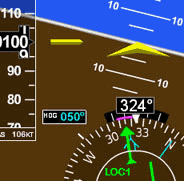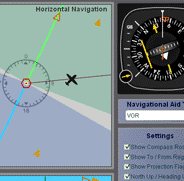|
III - Blockage Scenarios - Description
Note: The scenarios below are generalized for complete blockages. The actual behavior of the instruments may be more complex and confusing if the blockages are partial or intermittent.
1a. Static port blocked, but ram air and Pitot tube drain remain unobstructed.
Effect: The altimeter will stay on the altitude that the blockage occurred regardless if the aircraft climbed or descended; vertical speed indicator will indicate zero climb or descent; airspeed indicator will continue to measure airspeed, however above the altitude where the blockage occurred the airspeed shown by the instrument will be less than it would actually be if there were no blockage, and the opposite would occur below the blockage altitude where the aircraft indicates a higher airspeed.
Possible results if the pilot doesn't realize the issue: (a) the pilot flies a lower than normal speed when descending and may stall or have a higher descent rate because of the lower speed, principally on landing. (b) the pilot flies a higher than normal airspeed when the aircraft climbs, resulting in the possibility of over-speeding or high-speed stall.
Some possible* actions that may be taken: (a) recognize the issue and activate the alternate static air port. (b) use the attitude indicator for pitch and fly with the usual power settings and configuration if the alternate static air port doesn't solve the issue. (c) in non-pressurized aircraft depending on the instrument, it may be possible to crack the glass of the vertical speed indicator to allow the cabin air to act as an alternate static air port (note however that the vertical speed indicator will not be usable).
Note: If the ram air then becomes obstructed after the static port, the problem in scenario 1a becomes scenario 1b.
1b. Ram air and static port blocked (regardless of order); Pitot tube drain remains unobstructed.
Effect: The airspeed indicator drops to zero at the moment ram air is blocked; when the static air blockage occurs, both the altimeter (stays at indication where the blockage occurred regardless of altitude change) and vertical speed indicator (indicates zero climb regardless of current climb rate) are affected.
Some possible*actions that may be taken: (a) activate Pitot heat (if this is a blockage due to ice, heat may resolve the issue). (b) if the aircraft is equipped with another airspeed indicator that uses a separate Pitot tube check if that is working. (c) keep flying the aircraft and use the attitude indicator for pitch and the usual power settings and configuration for that flight regime. (d) if equipped, the GPS may provide an idea of what the airspeed is based on its reading of true airspeed (remember that there may be a lag between your actual airspeed and the value provided by the GPS; also be cautious because true airspeed is typically higher than indicated airspeed); (e) recognize the issue and activate the alternate static air port if available. (f) in non-pressurized aircraft depending on the instrument, it may be possible to crack the glass of the vertical speed indicator to allow the cabin air to act as an alternate static air port if one is not available (note however that the vertical speed indicator will not be usable).
Note: If the Pitot tube drain then becomes obstructed afterwards, the problem becomes scenario 1e.
1c. Static port and Pitot tube drain blocked (regardless of order); but ram air remains unobstructed.
Effect: Exactly the same as scenario 1a (will affect the altimeter and VSI). Even with the Pitot tube drain being blocked the pilot should not notice any difference in airspeed indication as long as the ram air remains unobstructed.
Note: If the ram air then becomes obstructed after the Pitot tube drain, the problem becomes scenario 1d.
1d. Pitot tube drain blocked; ram air blocked after Pitot drain; static port drain blocked (regardless of order).
Effect: Until all three are blocked refer to the previous scenarios per the appropriate order of failure. When the blockages are complete (all three), this will cause all of the Pitot-static instruments to freeze at their current readings. Because of this the complete failure may be easier to identify than the previous ones because the pilot will probably notice immediately that there is something wrong since: the airspeed indicator freezes when Pitot tube drain gets blocked followed by the ram air getting blocked; the altimeter freezes when static port is blocked; and the VSI freezes as well when the static port gets blocked.
Some possible* actions: (a) if ice is a possibility, activate the Pitot heat. (b) if the attitude indicator is functional, fly the usual attitude and power for that particular flight regime and investigate. (c) use the GPS indication of speed, if available, to have a rough idea of your airspeed. Remember that the GPS will be showing true airspeed which is usually higher than indicated airspeed, principally at higher altitudes. Workload permitting, use a flight computer to calculate the indicated airspeed based on that true airspeed shown by the GPS. (d) proceed to an airport with visual conditions if possible. (e) ask air traffic control if possible for your current altitude, but remember that if your transponder’s altitude function is connected to the same, or a static port that is also blocked, they will probably also have the wrong altitude on their screens. (f) activate the alternate static air port if available. This will allow the altimeter and VSI to work however if the drain port and the ram air port continue to be blocked, this scenario will be as the one described in (3b or 2b). (g) if the alternate static air port is not available or does not function, use the GPS to get a rough idea of your altitude, remembering that the GPS may not be very precise for altitude, particularly on older models and models that are not IFR approved for vertical navigation. When possible fly well above the altitude of any obstacles in the area to compensate for this. Know your GPS's limitations.
1e. Ram air blocked; Pitot tube drain after ram air; static port drain blocked (regardless of order).
This is the same as scenario 1d except that if the ram air gets blocked before the Pitot tube drain the airspeed indication will drop to zero then freeze at zero (as opposed to just freezing at its current indication). The Altimeter and VSI will still freeze at their current indications when the static port is blocked.
Some possible*actions: see scenario 1d.
2a. Ram air blocked, but static port and Pitot tube drain remain unobstructed.
Effect: Airspeed indicator drops to zero; both the altimeter and vertical speed indicator are not affected since they don't use the ram air pressure.
Some possible*actions that may be taken: (a) activate Pitot heat (if this is a blockage due to ice, heat may resolve the issue). (b) if the aircraft is equipped with another airspeed indicator that uses a separate Pitot tube check if that is working. (c) keep flying the aircraft and use the attitude indicator for pitch and the usual power settings and configuration for that flight regime. (d) if equipped, the GPS may provide an idea of what the airspeed is, based on its reading of true airspeed (remember that there may be a lag between your actual airspeed and the value provided by the GPS; also be cautious because true airspeed is typically higher than indicated airspeed)
Note: If the static air then becomes obstructed after the ram air port, the problem becomes scenario 1b. If the Pitot tube drain becomes obstructed as well after the ram air port, the problem becomes scenario 2b.
2b. Ram air blocked first and then Pitot tube drain blocked; static port drain remains unobstructed.
Effect: Similar to the (3b) scenario except that air speed will drop to zero at the moment the ram air gets blocked. When the Pitot tube drain gets blocked next, it will trap air inside the Pitot tube chamber. Above the altitude where the drain gets blocked the airspeed indication will increase from zero. Since airspeed indication will increase with altitude the pilot may pull back on the yoke, just as in scenario 3b, resulting in a possible stall or spin. Also, just as in 3b, the actual airspeed will have no effect on the instrument since the ram air is blocked.
Note: If the static port then becomes obstructed after the Pitot tube drain and ram air, the problem becomes scenario 1e.
Some possible*actions: see scenario 3b.
3a. Pitot tube drain blocked; ram air and static air ports remain unobstructed.
Effect: There should be little to no effect unless the ram air port becomes blocked. This is because the Pitot tube drain is very small compared to the ram air opening. If it is blocked it will just stop draining water that enters from the ram air. Eventually this water could flood the Pitot tube and block the ram air from inside.
Some possible* actions: (a) if ice is a possibility, activate the Pitot heat.
Note: If the ram air becomes obstructed as well after the Pitot tube drain, the issue becomes scenario 3b. If the static air becomes obstructed after the Pitot tube drain, the issue becomes scenario 1c.
3b. Pitot tube drain blocked first; then ram air blocked; static port remains unobstructed.
Effect: If the Pitot tube drain gets blocked, initially there is little difference until the ram air port gets blocked as well. At that moment pressure gets trapped inside the Pitot tube ram air chamber. If the aircraft remains at the same altitude where the two blockages occurred the airspeed indicator will remain at the same airspeed indication regardless of any actual changes in the aircraft's airspeed. If the aircraft descends that airspeed indication will decrease regardless of the aircraft's airspeed. If the aircraft climbs the airspeed indication will increase regardless of the aircraft's airspeed. Basically the airspeed will have an altimeter like behavior, increasing and decreasing with altitude. Of the blockage scenarios this one can be one of the most dangerous. The pilot is used to the airspeed increasing if he/she pushes the yoke forward and decreasing if he/she pushes back on the yoke. The exact opposite happens in this scenario. Â The pilot pushes back on the yoke and because the altitude will increase momentarily, the airspeed will show an increasingly higher indication. The pilot may continue to pull back on the yoke and decrease power thinking that the indicated airspeed will decrease, not realizing that the aircraft is slowing and possibly reaching its stall speed. In the opposite direction, if the pilot pushes the yoke forward the aircraft will start to descend and because of this the airspeed indication will decrease due to the blockages, the pilot then may apply more forward pressure on the yoke and perhaps add more power causing the aircraft to go faster and overspeed or get out of control into the ground. This is particularly hazardous when there are no outside references in IFR. If you notice that the air speed decreases when the nose of the aircraft goes down and increases when the nose goes up this failure scenario should be considered.
Some possible* actions: (a) if ice is a possibility, activate the Pitot heat. (b) if the attitude indicator is functional, fly the usual attitude and power for that particular flight regime and investigate. (c) use the GPS indication of speed, if available, to have a rough idea of your airspeed. Remember that the GPS will be showing true airspeed which is usually higher than indicated airspeed, principally at higher altitudes. Workload permitting, use a flight computer to calculate the indicated airspeed based on that true airspeed shown by the GPS. (d) proceed to an airport with visual conditions if possible.
Note: If the static port then becomes obstructed after the ram air and Pitot tube drain, the problem becomes scenario 1d.
Actions that can help mitigate/prevent the situations above
General actions* on the ground:
a) Make sure the Pitot tube and static port protection covers, if any, are removed before flight.
b) Thoroughly inspect the Pitot tube and static air port in the preflight inspection for any obstruction.
c) Test if the Pitot heat is working. On smaller aircraft it is possible to turn the Pitot heat switch on and then check if the Pitot tube is warming up (it can get really hot and care must be taken not to burn fingers or hand). On larger aircraft an infrared thermometer may be used from a distance pointed at the Pitot tube, or a ladder to feel the Pitot tube while someone in the cockpit turns the Pitot heat on.
d) When the aircraft is parked, use covers when available to prevent debris, or insects from blocking the ports and openings.
e) These blockage scenarios should be practiced in an appropriate simulator. Having experience is crucial to recognizing and acting correctly. Experiencing these in the aircraft for the first time can be deadly.
*These actions may or may not be appropriate, always use manufacturer’s recommendations and emergency procedures. Consult a flight instructor that is rated and current in your aircraft as to the particular actions that should be taken for these situations.
|




